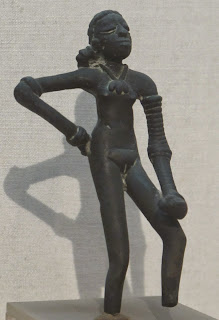- By Deepa Krishnan
I was walking in Jaisalmer, when I came upon a man making string puppets (marionettes).
The puppeteers are Bhats of the Rajasthani Nat community, who are
storytellers in the bardic tradition. The Bhats not only make puppets, but also use them to perform folk tales set to music and song.
Rajasthan's puppetry tradition is very old. The Bhats trace their history back to the legendary king Vikramaditya of Ujjain, who is said to have ruled central India in the 1st century BCE. Vikramaditya's famous Throne of Wisdom, called the Sinhasan Battisi, had 32 talking dolls, which (
according to this book) are possibly the earliest account of puppets made by this community in India.
In olden times, the Bhats went from village to village with their
puppets, enacting much beloved legends. Royalty and noblemen patronised specific Bhat families, and in return,
the puppeteers composed ballads in praise of their patrons. In other words, the Bhats were to kings, what PR agencies are to corporates :)
Prithiviraj Chauhan, who ruled Ajmer and Delhi in the 12th century, was a major patron of the Bhats. Ballads celebrating his daring elopement with Samyukta, and his battlefield exploits against Muhammad Ghor, were performed by the Bhats all over north India. Prithviraj was routed, captured and put to death by Ghor, but balladeers and puppeteers went on to construct an elaborate myth about an archery competition, where a blind Prithviraj shoots an arrow unerringly at Ghor and strikes him dead. The legend of Prithviraj Chauhan's revenge on Muhammad Ghor has endured for more than 800 years, and is a widely accepted version of the truth.
 |
| Scene from Prithviraj Raso: Samyuka is love-struck by Kama's arrows |
Another major patron of the Rajasthani Nat community was Amar Singh Rathore, a hot-headed 17th century nobleman from the house of Marwar (Jodhpur). He was exiled by his father after a fight; and found employment in the Mughal court, where he became the
subedar of Nagaur under Shah Jahan. In this new employment, he squabbled with another courtier, and stabbed him right in Shah Jahan's court. In the melee that ensued, he narrowly escaped from Agra Fort with his life, after jumping across the moat on a horse. Later, one of Amar Singh's clansmen inveigled him back to Agra Fort and stabbed him.
I do not see Amar Singh's life as particularly heroic; in fact, I only see a quarrelsome guy with a strong instinct for self presevation! :) :) But that is not how the bards sing it. The puppeteers of Nagaur tell a stirring tale of what a dashing hero he was, and what a martyr his horse was. They sympathetically present his terrible betrayal and stabbing, and tell a grand tale of how his body was rescued from Agra Fort. The puppeteers of Nagaur have made Amar Singh Rathore into a Rajasthani legend. His story is popular in the desert regions of Rajasthan and performed with much dramatic flair at religious fairs even today.
 |
| Scene from Shah Jahan's court: Amar Singh Rathore is insulted by Salabat Khan |
In spite of the popularity, influence and wide geographical spread of Rajsthani puppet shows, puppetry as a craft is dying today. The reasons are easy to find. Today, there are no royal patrons (in fact, the decline in patronage set in right from Mughal times). With the advent of radio and television, traditional rural performances have competition from modern entertainment channels. The wide availability of mobile phones has brought a lot of new music within the reach of audiences in remote locations. Old themes / folk tales do not appeal as much to the new generation as Bollywood.
The Bhat
community has adapted themselves to modern times. Some performers have incorporated tunes from popular Bollywood movie songs into their repertoire. Instead of long ballads, they have produced short-duration performances aimed at tourists (who typically have very short attention spans).
But many have given up their oral performances, and morphed simply into makers of colourful wood-and-cloth puppets. They are often seen in the bigger cities of Rajasthan, where tourists buy their attractive products. Rajasthani puppets are typically about 2 feet tall, but many are smaller as well. The local word for them is
kathputhli. The word kath means
wood, and
puthli is a doll.
 |
| Beautifully decorated kathputli |
Puppets are made out of soft wood, usually something like mango wood. While the carving of the wood is usually done by men, women make the decorative fabrics and clothes for the puppets. Puppets used for performances are usually never destroyed; even when
they are broken. Instead, they are consigned to the river, to float
away.
Puppeteers live in Nagaur, Bikaner, Ajmer, Udaipur and Jaipur, but wander all through Rajasthan performing and selling their dolls. If you are visiting any major city in Rajasthan, you will definitely be able to see a show. And do stop to buy some of these colourful dolls - they make great souvenirs from Rajasthan to take back home!





















